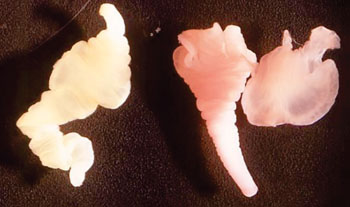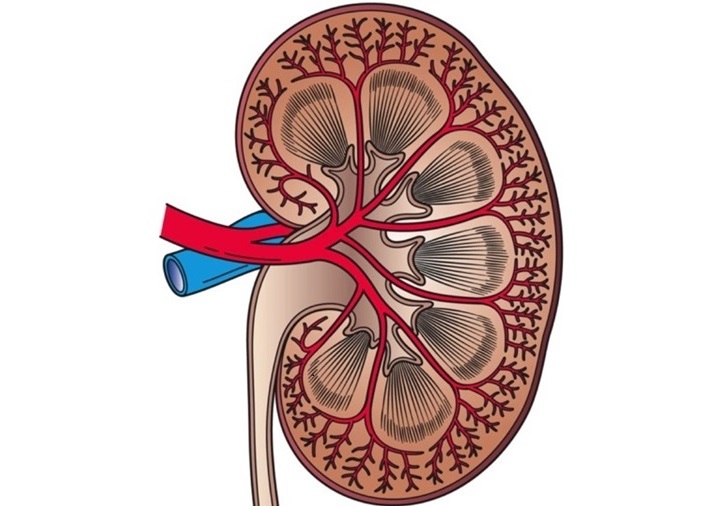Screening Tool Simplifies Serological Diagnosis of Neurocysticercosis
|
By LabMedica International staff writers Posted on 24 Jul 2014 |

Image: Taenia solium cysticerci, which represent the larval or intermediate, immature developmental stages of this pork tapeworm (Photo courtesy of Dr. George R. Healy).
The availability of a rapid serological diagnosis that targets stage-specific antibodies for human cysticercosis is considered very helpful in control programs for estimating the sero-prevalence or burden of the disease in susceptible population groups.
Cysticercosis is a tissue infection caused by hatched oncospheres, a larval form of the pork tapeworm Taenia solium which parasitize the intestinal wall and circulate through the bloodstream, invade the nervous system and form cysts in the brain, leading to neurocysticercosis.
Medical parasitologists at the Leiden University Medical Center (The Netherlands) and their American colleagues developed a field-friendly screening tool to simplify serological diagnosis of neurocysticercosis. A total of 63 banked serum samples from patients with confirmed neurocysticercosis were used to validate the assay, and a total of 170 serum samples collected in regions where transmission of cysticercosis does not occur, were used to assess specificity. These samples consisted of a panel of 78 serum samples assembled from healthy residents of the USA and a panel of 92 serum samples from blood bank donors in the Netherlands.
The assay utilizes novel nano-sized up-converting phosphor (UCP) reporter particles in combination with a portable lightweight analyzer and detects antibodies in serum samples reactive with bacterial-expressed recombinant (r) T24H, a marker for detecting neurocysticercosis cases. Three sequential flow steps allow enrichment of antibodies on the Test (T) line and consecutive binding of protein-A coated UCP reporter particles. Antibody binding was determined by measuring 550-nm emission after excitation of the UCP label with a 980 nm infrared (IR) diode. Lateral flow (LF) strips were scanned using a multistrip scanner, modified Packard Fluorocount microplate reader (PerkinElmer; Waltham, MA, USA) and a customized ESEQuant lateral flow reader (LFR) (QIAGEN Lake Constance; Stockach, Germany).
The clinical sensitivity and specificity of the assay to detect cases of human neurocysticercosis with two or more viable brain cysts were 96% and 98%, respectively, using a sample set comprised of sera from 63 confirmed cases and 170 healthy parasite-naïve non-endemic controls. The evaluation of the new test with a set of clinical samples indicated excellent clinical parameters comparable to an enzyme-linked immunosorbent assay (ELISA). Application of new nano-sized UCP reporter label and a lightweight strip analyzer, both from easily accessible sources, demonstrated equivalent performance compared to previous studies. The study was published on July 3, 2014, in the journal Public Library of Science Neglected Tropical Diseases.
Related Links:
Leiden University Medical Center
PerkinElmer
QIAGEN
Cysticercosis is a tissue infection caused by hatched oncospheres, a larval form of the pork tapeworm Taenia solium which parasitize the intestinal wall and circulate through the bloodstream, invade the nervous system and form cysts in the brain, leading to neurocysticercosis.
Medical parasitologists at the Leiden University Medical Center (The Netherlands) and their American colleagues developed a field-friendly screening tool to simplify serological diagnosis of neurocysticercosis. A total of 63 banked serum samples from patients with confirmed neurocysticercosis were used to validate the assay, and a total of 170 serum samples collected in regions where transmission of cysticercosis does not occur, were used to assess specificity. These samples consisted of a panel of 78 serum samples assembled from healthy residents of the USA and a panel of 92 serum samples from blood bank donors in the Netherlands.
The assay utilizes novel nano-sized up-converting phosphor (UCP) reporter particles in combination with a portable lightweight analyzer and detects antibodies in serum samples reactive with bacterial-expressed recombinant (r) T24H, a marker for detecting neurocysticercosis cases. Three sequential flow steps allow enrichment of antibodies on the Test (T) line and consecutive binding of protein-A coated UCP reporter particles. Antibody binding was determined by measuring 550-nm emission after excitation of the UCP label with a 980 nm infrared (IR) diode. Lateral flow (LF) strips were scanned using a multistrip scanner, modified Packard Fluorocount microplate reader (PerkinElmer; Waltham, MA, USA) and a customized ESEQuant lateral flow reader (LFR) (QIAGEN Lake Constance; Stockach, Germany).
The clinical sensitivity and specificity of the assay to detect cases of human neurocysticercosis with two or more viable brain cysts were 96% and 98%, respectively, using a sample set comprised of sera from 63 confirmed cases and 170 healthy parasite-naïve non-endemic controls. The evaluation of the new test with a set of clinical samples indicated excellent clinical parameters comparable to an enzyme-linked immunosorbent assay (ELISA). Application of new nano-sized UCP reporter label and a lightweight strip analyzer, both from easily accessible sources, demonstrated equivalent performance compared to previous studies. The study was published on July 3, 2014, in the journal Public Library of Science Neglected Tropical Diseases.
Related Links:
Leiden University Medical Center
PerkinElmer
QIAGEN
Latest Immunology News
- Advanced Imaging Method Maps Immune Cell Connections to Predict Cancer Patients Survival
- Computational Tool Predicts Immunotherapy Outcomes for Metastatic Breast Cancer Patients
- Biomarker Could Predict Immunotherapy Response in Liver Cancer
- Epigenetic Test Could Determine Efficacy of New Immunotherapy Treatments Against Multiple Myeloma
- Blood Test Predicts Survival in Liver Cancer Patients
- Simple Blood Test Identifies Multiple Myeloma Patients Likely to Benefit from CAR-T Immunotherapy
- Portable Device Analyzes White Blood Cell Activity to Monitor Cancer Patients’ Health
- New Test Detects Return of Blood Cancer a Year Earlier
- Universal Blood Test Could Predict Organ Transplant Outcomes with Unprecedented Accuracy
- AI Tool Predicts Cancer Patients’ Response to Immunotherapy
- Molecular Profiling Improves Diagnosis for Children with High Risk Cancers
- Blood Test Measures Immune Response to Epstein-Barr Virus in MS Patients
- AI Predicts Tumor-Killing Cells with High Accuracy
- Diagnostic Blood Test for Cellular Rejection after Organ Transplant Could Replace Surgical Biopsies
- AI Tool Precisely Matches Cancer Drugs to Patients Using Information from Each Tumor Cell
- Genetic Testing Combined With Personalized Drug Screening On Tumor Samples to Revolutionize Cancer Treatment
Channels
Clinical Chemistry
view channel.jpg)
POC Saliva Testing Device Predicts Heart Failure in 15 Minutes
Heart failure is a serious condition where the heart muscle is unable to pump sufficient oxygen-rich blood throughout the body. It ranks as a major cause of death globally and is particularly fatal for... Read more
Screening Tool Detects Multiple Health Conditions from Single Blood Drop
Infrared spectroscopy, a method using infrared light to study the molecular composition of substances, has been a foundational tool in chemistry for decades, functioning similarly to a molecular fingerprinting... Read more
Integrated Chemistry and Immunoassay Analyzer with Extensive Assay Menu Offers Flexibility, Scalability and Data Commutability
As global healthcare systems increasingly shift towards networked laboratory operational models to enhance efficiency and patient access, there is a greater need for innovative solutions tailored to the... Read moreMolecular Diagnostics
view channel
cfDNA Testing Reduces Pregnancy Risks
The highly anticipated emergence of "precision medicine" promises customized technologies that can benefit individuals while potentially lowering healthcare costs. Now, new research suggests that pregnancy... Read more
Non-Invasive Biosensor Facilitates Early Kidney Disease Detection
Traditionally, kidney function has been assessed by measuring blood creatinine levels, which reflect muscle breakdown. Elevated creatinine levels may indicate that the kidneys are not effectively filtering waste.... Read moreHematology
view channel
Next Gen CBC and Sepsis Diagnostic System Targets Faster, Earlier, Easier Results
Every hour is critical in protecting patients from infections, yet there are currently limited tools to assist in early diagnosis before patients reach a hospital. The complete blood count (CBC) is a common... Read more
Newly Discovered Blood Group System to Help Identify and Treat Rare Patients
The AnWj blood group antigen, a surface marker discovered in 1972, has remained a mystery regarding its genetic origin—until now. The most common cause of being AnWj-negative is linked to hematological... Read more
Blood Platelet Score Detects Previously Unmeasured Risk of Heart Attack and Stroke
Platelets, which are cell fragments circulating in the blood, play a critical role in clot formation to stop bleeding. However, in some individuals, platelets can become "hyperreactive," leading to excessive... Read moreImmunology
view channel.jpg)
Advanced Imaging Method Maps Immune Cell Connections to Predict Cancer Patients Survival
A growing tumor is influenced not only by the tumor cells themselves but also by the surrounding tissue, which alters its biology. Immune cells communicate by transferring vital signaling proteins to their... Read more
Computational Tool Predicts Immunotherapy Outcomes for Metastatic Breast Cancer Patients
Immunotherapy aims to enhance the body’s immune response to target cancer cells, but not all patients experience a positive reaction to such treatments. Identifying which patients will benefit from immunotherapy... Read more
Biomarker Could Predict Immunotherapy Response in Liver Cancer
Until recently, patients diagnosed with hepatocellular carcinoma had limited treatment options, with existing therapies extending life by only a few months. Immunotherapy has emerged as a new alternative... Read more
Epigenetic Test Could Determine Efficacy of New Immunotherapy Treatments Against Multiple Myeloma
Multiple myeloma is a blood cancer that primarily affects individuals over the age of sixty, and its occurrence rises as the population ages. In this disease, the bone marrow—the spongy tissue inside bones... Read morePathology
view channel
AI Tool Uses Imaging Data to Detect Less Frequent GI Diseases
Artificial intelligence (AI) is already being utilized in various medical fields, demonstrating significant potential in aiding doctors in diagnosing diseases through imaging data. However, training AI... Read moreAI-Based Method Shows Promise for Pathological Diagnosis of Hereditary Kidney Diseases
Alport syndrome is a hereditary kidney disorder characterized by kidney dysfunction, sensorineural hearing loss, and ocular abnormalities. Early in the disease, patients experience hematuria, which is... Read moreTechnology
view channel
New Noninvasive Methods Detect Lead Exposure Faster, Easier and More Accurately at POC
Exposure to lead can negatively affect health in multiple ways, leading to damage in the brain and central nervous system, delays in development and growth, learning and behavioral issues, problems with... Read more
Noninvasive Test Detects Malaria Without Blood Sample
Malaria remains a significant global health issue, with approximately 250 million cases and over 600,000 deaths reported annually. Nearly half of the world's population is at risk for malaria infection,... Read moreIndustry
view channel
Microbiologics Acquires Diagnostic Quality Controls Manufacturer SensID
Microbiologics (St. Cloud, MN, USA), a biotechnology company specializing in infectious disease reference materials and contract research services, has acquired SensID (Rostock, Germany), a manufacturer... Read more



















_1.jpg)
